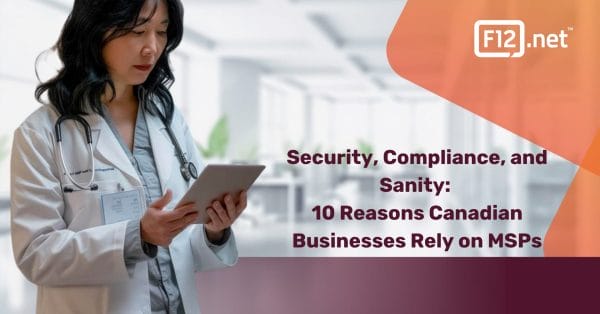Brief: When it comes to IT, knowing your limits isn’t weakness. It’s leadership. That’s the truth more Canadian mid-sized businesses are facing in 2025 as the demands on internal IT teams continue to mount. AI is everywhere. Cyber threats are relentless. Compliance rules are tightening. And the board still expects performance, continuity, and proof. Enter co-managed IT. Done right, it’s not an outsourcing play. It’s an operational advantage—a strategic extension of your internal IT bench, with the security depth, compliance muscle, and outcome-based accountability modern businesses require.
“A man’s got to know his limitations.” — Dirty Harry
Here’s what to look for in a co-managed IT partner that actually protects your business, not just your ticket queue.
1. Security Leadership at the Core
If a potential partner talks about patching endpoints before protecting your business, walk away. The right co-managed IT partner brings board-level Cyber Security thinking to the table from day one – risk mapping, AI governance, incident response playbooks, disaster recovery readiness, and third-party threat modelling.
They don’t just ask for admin access. They ask:
- What’s your most critical data flow?
- Who owns recovery if this platform goes down?
- Do you know what AI tools are in use inside your organisation right now?
You don’t need more IT support. You need someone who can spot the risk you’ve normalised.
Ask: Who leads your security practice? How do you report risk to business leadership?
2. Outcomes, Not Activity
A lot of MSPs still sell the basics:
- Response times
- Patch frequencies
- Ticket closure SLAs
That’s not enough anymore.
You should be asking about Protection Level Agreements and Outcome-Driven Metrics clear measurements that prove business risk is going down and operational resilience is going up.
At F12, we report on:
- Time to detect and contain incidents
- Exposure reduction by asset class
- Compliance evidence status
- Business continuity impact risk
- Cost-of-inaction estimates
Ask: What outcomes do you track? What format are they delivered in?
3. Compliance-as-a-Service, Not a Sideshow
With Bill C-26 moving forward, and privacy frameworks like PIPEDA and PHIPA under sharper scrutiny, compliance isn’t just for banks and hospitals anymore.
If your IT partner treats compliance as a one-time checklist or “add-on audit package,” you’re exposed.
A strong co-managed provider should:
- Continuously monitor compliance gaps
- Map their controls to Canadian frameworks
- Provide evidence logs, reporting formats, and documentation templates
- Support your responses to vendor, customer, and regulatory audits
- And do all of it without you needing to ask
Ask: Do you support Canadian-specific compliance reporting? What evidence can you produce if we’re audited tomorrow?
4. Modular Support That Flexes With You
You shouldn’t have to buy a bundle to get the one service your team actually needs.
A real co-managed partner doesn’t force a full-stack replacement. They start by asking:
What are your internal strengths? What gaps are costing you sleep?
At F12, we call this our Enablements model—modular, business-aligned managed services that flex with your operational maturity and risk posture.
Want only compliance documentation support, or MDR layered into your stack? Done. Want full-service IT plus AI governance and strategic roadmap planning? Also done.
Ask: Can we start with what we need now, and expand based on business priorities—not service quotas?
5. Real-Time Visibility, Not Post-Mortems
If you find out about a major threat during a QBR, it’s already too late.
You need a partner who can plug into your monitoring tools, provide real-time alerts, escalate when thresholds are crossed, and give shared situational awareness with your internal team.
Modern co-managed means:
- Live dashboards (accessible to both sides)
- Joint incident response drills
- Shared toolsets with defined owner roles
- Clear, immediate communications—not “check the ticket queue”
Ask: Do we have access to a shared live security dashboard? What triggers escalation?
6. Dark Web, Shadow IT, and AI Governance
Cyber threats aren’t just ransomware anymore. The real risks today come from:
- Unsanctioned AI tools
- Unmanaged SaaS subscriptions
- Credential leaks on the dark web
- Over-permissive access policies
- Unmonitored BYOD endpoints
Co-managed IT should address this proactively with policies, detection, and action. You’re not just securing your tech stack anymore. You’re securing the way people work.
Ask: How do you handle SaaS sprawl, AI governance, and credential leak detection?
7. Audit-Ready Documentation and Board Reporting
A co-managed partner should make you look prepared, not just keep you afloat.
That means:
- Pre-built documentation libraries
- Evidence logs aligned to CyberSecure Canada, ISO 27001, and Bill C-26
- Audit response support
- Board-ready visuals and reporting language—translated from tech to risk
- Measured improvement tracking (not just fire drills)
Ask: Do you support board-level reporting and audit response? What format is your evidence tracking in?
8. The Ability to Say: “No, That’s Not Secure.”
Your partner should never be a yes-person.
The right co-managed provider will tell the truth, even when it’s uncomfortable. They’ll escalate security concerns if they’re not being addressed. They’ll bring the receipts.
In our model, trust doesn’t come from niceness. It comes from showing up with clarity when things go wrong.
Ask: Will you escalate to senior leadership if a security issue isn’t being addressed?
Co-Managed Doesn’t Mean Compromise
It means visibility.
It means alignment.
It means measurable confidence.
At F12, we don’t replace your team. We equip them. We fill in the gaps without duplicating effort. And we hold ourselves accountable to the same outcomes your board is tracking.
If your internal IT team is under pressure—and your business can’t afford vague promises—it might be time to bring in help that measures what matters.
Let’s Talk
If you’re not sure where your current coverage ends and your real exposure begins, we’ll help you find out—before your regulator or insurer does.
Book a no-cost risk readiness session.
We’ll review your posture, find the blind spots, and show you where co-managed IT can put your team back in control.
FAQs: Co-Managed IT, Security, and Compliance
- What is co-managed IT? Co-managed IT is a collaborative support model where your internal IT team retains strategic control while an external MSP provides operational support, security services, and governance expertise.
- Is co-managed IT just outsourcing with a new name? Not at all. Traditional outsourcing removes control. Co-managed IT enhances it—with shared tools, shared visibility, and joint accountability for outcomes.
- What’s the main benefit of co-managed IT in Canada? You gain resilience and compliance coverage without expanding headcount—especially critical in sectors with PIPEDA, PHIPA, or Bill C-26 obligations.
- Who owns risk in a co-managed model? Risk is shared but a good partner helps you measure, report, and reduce it in real time. It’s not about shifting blame. It’s about shared responsibility with clear accountability.
- What kind of outcomes should a co-managed partner deliver?
- Threat detection and response time
- Compliance evidence and audit readiness
- SLA and PLA tracking
- Business continuity risk reduction
- AI governance support



